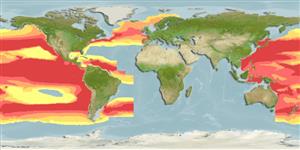>
Stomiiformes (Lightfishes and dragonfishes) >
Sternoptychidae (Marine hatchetfishes) > Sternoptychinae
Etymology: Argyropelecus: Greek, argyros = silvered, silver + Greek, pelekys = axe (Ref. 45335).
More on author: Garman.
Environment: milieu / climate zone / depth range / distribution range
Écologie
marin bathypélagique; profondeur 150 - 700 m (Ref. 35838). Deep-water
Western Pacific: Papua New Guinea (Ref. 6993) and New Zealand (Ref. 5755). Eastern Pacific: southern British Columbia, Canada to California, USA and farther south (Ref. 2850).
Taille / Poids / Âge
Maturity: Lm ? range ? - ? cm
Max length : 7.0 cm TL mâle / non sexé; (Ref. 30504)
Épines dorsales (Total): 0; Rayons mous dorsaux (Total): 9; Épines anales 0; Rayons mous anaux: 12; Vertèbres: 35 - 37. Branchiostegal rays: 10 (Ref. 35838). Lower preopercular spine downward and curved forward, upper preopercular spine curved outward. Two postabdominal spines directed ventrally (Ref. 37473).
Copepods have been found in the food items consumed by this species (Ref. 6885). Oviparous, with planktonic eggs and larvae (Ref. 35838). Minimum depth is from Ref. 82347.
Life cycle and mating behavior
Maturité | Reproduction | Frai | Œufs | Fécondité | Larves
Eschmeyer, W.N., E.S. Herald and H. Hammann, 1983. A field guide to Pacific coast fishes of North America. Boston (MA, USA): Houghton Mifflin Company. xii+336 p. (Ref. 2850)
Statut dans la liste rouge de l'IUCN (Ref. 130435)
Menace pour l'homme
Harmless
Utilisations par l'homme
Outils
Articles particuliers
Télécharger en XML
Sources Internet
Estimates based on models
Preferred temperature (Ref.
123201): 3.3 - 16.3, mean 10.2 °C (based on 366 cells).
Phylogenetic diversity index (Ref.
82804): PD
50 = 0.5078 [Uniqueness, from 0.5 = low to 2.0 = high].
Bayesian length-weight: a=0.01862 (0.00804 - 0.04311), b=3.01 (2.82 - 3.20), in cm total length, based on LWR estimates for this Genus-body shape (Ref.
93245).
Niveau trophique (Ref.
69278): 3.0 ±0.16 se; based on food items.
Résilience (Ref.
120179): Haut, temps minimum de doublement de population inférieur à 15 mois (Preliminary K or Fecundity.).
Fishing Vulnerability (Ref.
59153): Low vulnerability (10 of 100).
